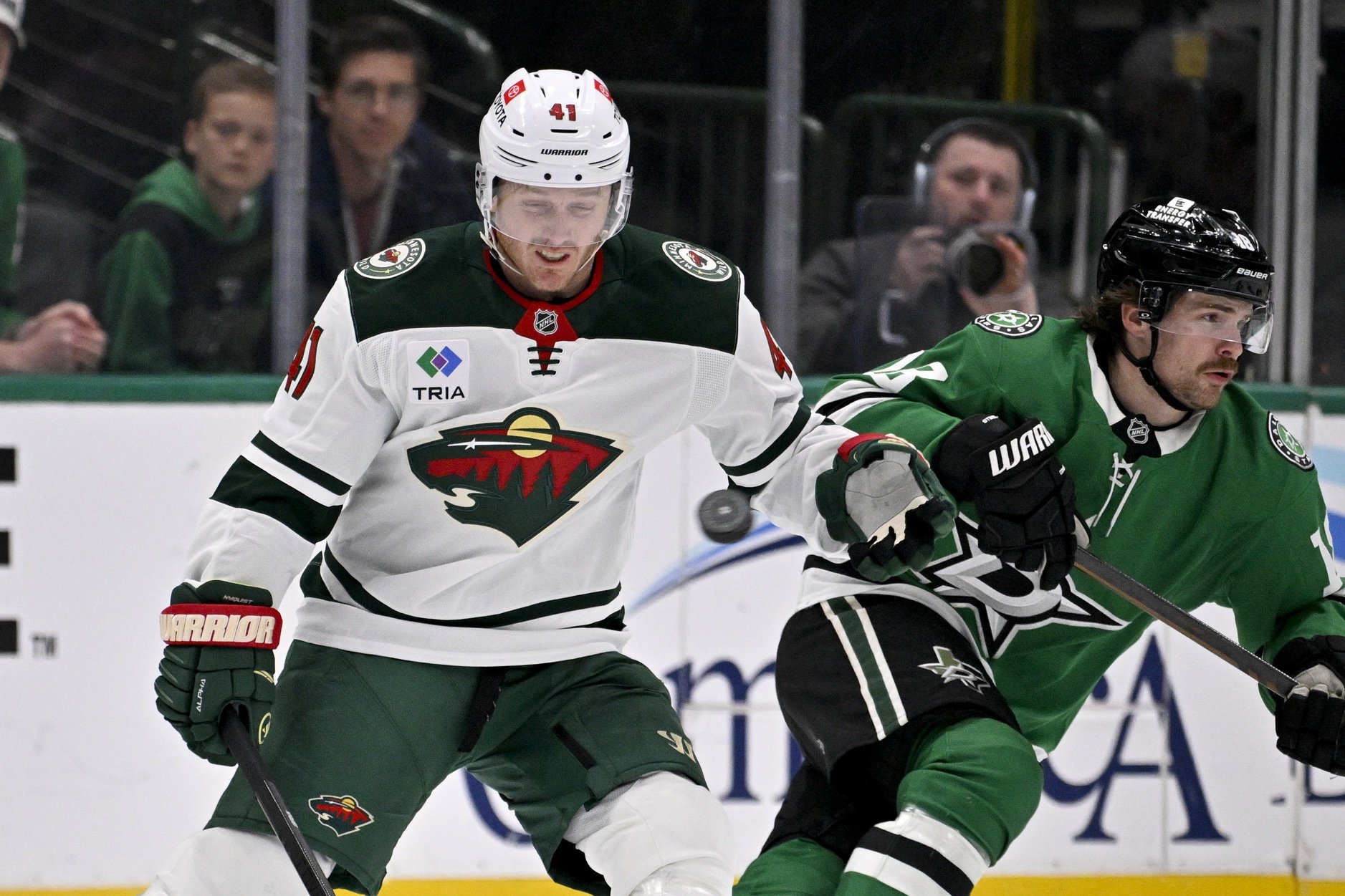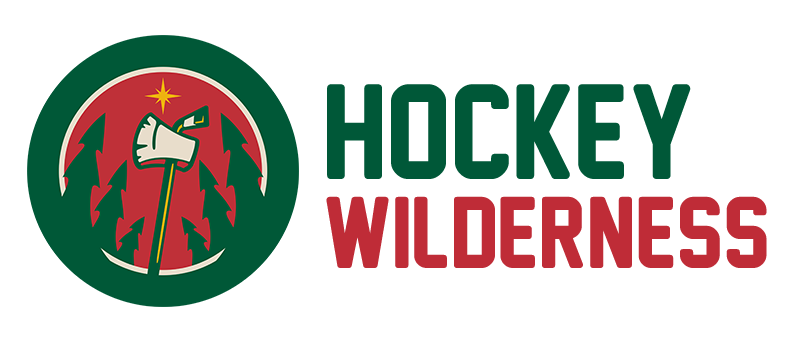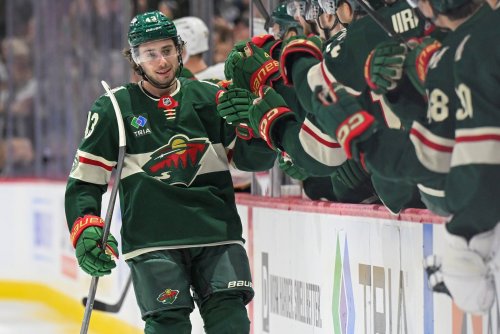
We can all agree that the Minnesota Wild are having a weird season.
For a month, they seemed like a team capable of making a deep run, surprising though it was. Then, a second-straight injury-riddled season raised a complicated question at the trade deadline.
Are the Wild buyers or sellers?
The team was back-sliding into the playoffs, but the opening-night lineup seemed on schedule to be healthy for the playoffs. On top of that, the Wild had clear incentives to buy. Around the trade deadline, sportsbook odds had Minnesota at 60-to-1 to make the playoffs but only about a 36% chance to win a single playoff round. A major deadline addition could have significantly raised the latter figure.
Acquiring Gustav Nyquist for a future second-round pick seemed to reveal Bill Guerin’s answer to that question. Nyquist is a small-impact one-year rental acquired for a relatively low price, given that the pick was deferred to the 2026 draft. Trading Marat Khusnutdinov and Jakub Lauko for Justin Brazeau was another marginal move, and it was driven by Lauko’s health and Khusnutdinov’s future with Minnesota more than anything else.
But fans were left wanting more with Minnesota’s top-six forward group starting Marcus Johansson most of the year and most of the Parise-Suter buyout penalties gone after this summer. Kirill Kaprizov and Joel Eriksson Ek’s injuries at the trade deadline opened the door to a unique opportunity to place $14.25 million of pro-rated cap space on LTIR.
Fans and bloggers alike wondered: Could the Wild have added a major piece for years to come, with essentially no impact on the 2024-25 salary cap?
It would have felt like a just end for the final year of $14.7 million cap penalties to be wiped out by an almost identical influx of LTIR cap relief. However, the impact of adding an eight-figure contract to the books wouldn’t only affect the near future. That player’s contract would need to fit into the Wild’s cap picture for the foreseeable future. What would that look like?
First, we must account for extensions for Kaprizov and Marco Rossi. Previously, I’ve estimated that that total cap hits would be about $7.2 million AAV to Rossi for a four-year bridge deal and about $17 million AAV for eight years of Kaprizov. In this exercise, Rossi is projected for a shorter, cheaper deal because (spoiler alert) the Wild cap situation gets tight within a couple of years after the buyout penalties are reduced.
In addition, Minnesota needs to make several other re-signings or replacements. Six players (Marcus Johansson, Nyquist, Brazeau, Declan Chisholm, Jon Merrill, and Marc-Andre Fleury) are set to depart in the 2025 offseason. Another four players (Mats Zuccarello, Vinnie Hinostroza, Zach Bogosian, and Filip Gustavsson) have expiring contracts in the 2026 off-season. The Wild must sign or replace those ten players.
Youngsters Danila Yurov, Zeev Buium, David Jiricek, Liam Ohgren, and Jesper Wallstedt will be part of the equation. So, here’s a realistic projection of replacing those players:
- Use Danila Yurov to replace Marcus Johansson on the 2nd line. If he becomes an NHL center, Hartman can play left wing on the 2nd line with Yurov, Rossi, and Joel Eriksson Ek centering the top three lines.
- Extend or replace one of Declan Chisholm and Jon Merrill for third-pair defense money, about $2.8 million AAV. Chisholm is younger, has performed better this season, and is an RFA, so that is likely a more efficient plan than retaining Merrill. But, Merrill would likely be available for a lesser price tag if necessary.
- Whichever of Merrill and Chisholm departs in free agency can be replaced by Jiricek or Buium.
- Replace Marc-Andre Fleury’s games with Jesper Wallstedt.
- Re-sign or replace Nyquist for fourth-line pay, about $1.5 million per year.
- Extend Brazeau for 3 years at $1 MM AAV, an acceptable offer per Frank Seravalli’s DFO Rundown podcast.
That team would likely make the playoffs on its own and has an extra roster spot to add a forward. But, there is only $4 million of cap space in 2025-26. On top of that, none of this accounts for Kaprizov’s raise.
This roster would likely be about $3.3 million over the 2026-27 cap, assuming replacements for Zuccarello ($9.37 million for a market-rate 2nd-line winger), Bogosian (Jiricek, assuming both he and Buium are NHL-ready), and Gustavsson ($7.54 million for a market-rate starting goaltender). This doesn’t even account for replacing Hinistroza, leaving only 12 forwards.
This plan does not include a path for Liam Ohgren, who could be on track to fill a middle-six role on the 2026-27 team. Even still, it would be optimistic to assume that he could replace Zuccarello’s 2024-25 production. And if the Wild don’t replace Zuccarello’s production, then adding a top-line forward with that cap savings probably doesn’t turn Minnesota into a true Stanley Cup contender. That describes more of a strong playoff team.
More importantly, none of these young players are guaranteed to make an NHL impact. Buium and Yurov haven’t played an NHL game, but they’ll need to replace Zuccarello and Merrill’s production to make this plan work. Ohgren’s development could taper off, and Jiricek is hurt. If anything, their inclusion in the original plan is optimistic and still leaves Minnesota $3.5 million over the cap in ‘26-27.
All this puts into context why contract negotiations with Minnesota are suddenly hot news items. Marco Rossi and Kirill Kaprizov are in line for some of the largest AAVs in Wild history. Their projections won’t match mine exactly, but that ‘26-27 salary cap seems to be Guerin’s greatest constraint. If he can squeeze half- or three-quarters of a million dollars out of Rossi and Kaprizov, it will give him flexibility against their own ‘26-27 cap projection.
There has never been so much pressure on this organization as there will be in the years when those extensions kick in. That will entice management to make aggressive and creative roster moves to maximize next year’s roster without exceeding the ‘26-27 salary cap. Minnesota probably needs to acquire a top-line forward playing at a below-market rate for the next two years.
That likely means one or more trades, including core pieces of the current roster, plus high-end prospects. In this scenario, nobody except Kaprizov would be off-limits.
The upshot for fans is this: July 1, 2025, is not only the date of a major addition, but it comes with intrigue. Guerin seems on track to make the most impactful off-season move in the entire NHL.
Anything short of that would be a disappointment.
Think you could write a story like this? Hockey Wilderness wants you to develop your voice, find an audience, and we'll pay you to do it. Just fill out this form.






Recommended Comments
Join the conversation
You can post now and register later. If you have an account, sign in now to post with your account.
Note: Your post will require moderator approval before it will be visible.